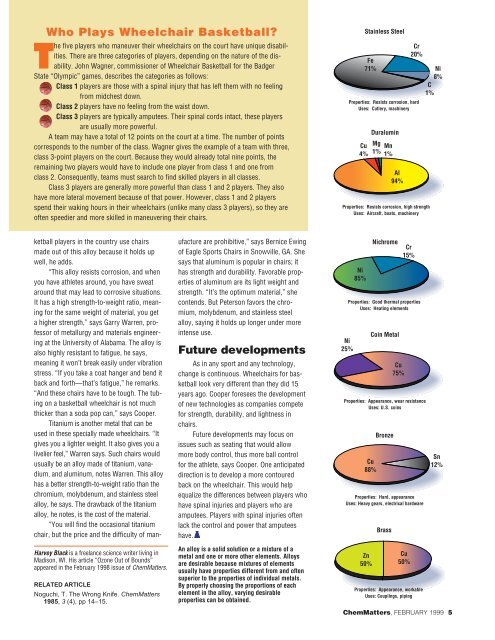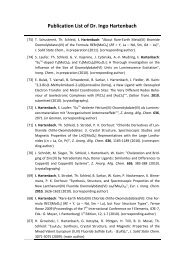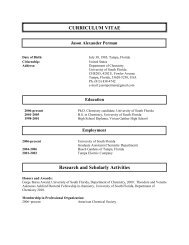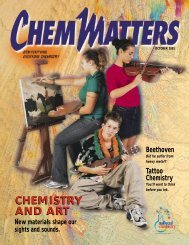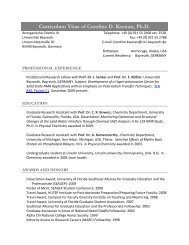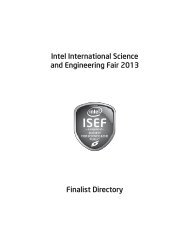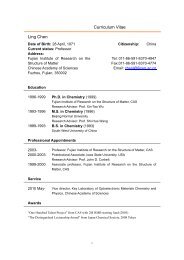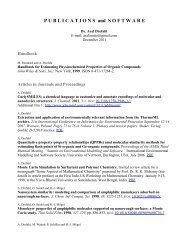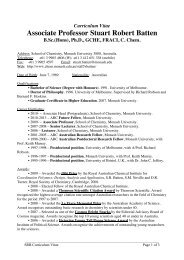Sports Drinks: Don't Sweat the Small Stuff - American Chemical ...
Sports Drinks: Don't Sweat the Small Stuff - American Chemical ...
Sports Drinks: Don't Sweat the Small Stuff - American Chemical ...
You also want an ePaper? Increase the reach of your titles
YUMPU automatically turns print PDFs into web optimized ePapers that Google loves.
Who Plays Wheelchair Basketball?<br />
The five players who maneuver <strong>the</strong>ir wheelchairs on <strong>the</strong> court have unique disabilities.<br />
There are three categories of players, depending on <strong>the</strong> nature of <strong>the</strong> disability.<br />
John Wagner, commissioner of Wheelchair Basketball for <strong>the</strong> Badger<br />
State “Olympic” games, describes <strong>the</strong> categories as follows:<br />
Class 1 players are those with a spinal injury that has left <strong>the</strong>m with no feeling<br />
from midchest down.<br />
Class 2 players have no feeling from <strong>the</strong> waist down.<br />
Class 3 players are typically amputees. Their spinal cords intact, <strong>the</strong>se players<br />
are usually more powerful.<br />
A team may have a total of 12 points on <strong>the</strong> court at a time. The number of points<br />
corresponds to <strong>the</strong> number of <strong>the</strong> class. Wagner gives <strong>the</strong> example of a team with three,<br />
class 3-point players on <strong>the</strong> court. Because <strong>the</strong>y would already total nine points, <strong>the</strong><br />
remaining two players would have to include one player from class 1 and one from<br />
class 2. Consequently, teams must search to find skilled players in all classes.<br />
Class 3 players are generally more powerful than class 1 and 2 players. They also<br />
have more lateral movement because of that power. However, class 1 and 2 players<br />
spend <strong>the</strong>ir waking hours in <strong>the</strong>ir wheelchairs (unlike many class 3 players), so <strong>the</strong>y are<br />
often speedier and more skilled in maneuvering <strong>the</strong>ir chairs.<br />
ketball players in <strong>the</strong> country use chairs<br />
made out of this alloy because it holds up<br />
well, he adds.<br />
“This alloy resists corrosion, and when<br />
you have athletes around, you have sweat<br />
around that may lead to corrosive situations.<br />
It has a high strength-to-weight ratio, meaning<br />
for <strong>the</strong> same weight of material, you get<br />
a higher strength,” says Garry Warren, professor<br />
of metallurgy and materials engineering<br />
at <strong>the</strong> University of Alabama. The alloy is<br />
also highly resistant to fatigue, he says,<br />
meaning it won’t break easily under vibration<br />
stress. “If you take a coat hanger and bend it<br />
back and forth—that’s fatigue,” he remarks.<br />
“And <strong>the</strong>se chairs have to be tough. The tubing<br />
on a basketball wheelchair is not much<br />
thicker than a soda pop can,” says Cooper.<br />
Titanium is ano<strong>the</strong>r metal that can be<br />
used in <strong>the</strong>se specially made wheelchairs. “It<br />
gives you a lighter weight. It also gives you a<br />
livelier feel,” Warren says. Such chairs would<br />
usually be an alloy made of titanium, vanadium,<br />
and aluminum, notes Warren. This alloy<br />
has a better strength-to-weight ratio than <strong>the</strong><br />
chromium, molybdenum, and stainless steel<br />
alloy, he says. The drawback of <strong>the</strong> titanium<br />
alloy, he notes, is <strong>the</strong> cost of <strong>the</strong> material.<br />
“You will find <strong>the</strong> occasional titanium<br />
chair, but <strong>the</strong> price and <strong>the</strong> difficulty of man-<br />
Harvey Black is a freelance science writer living in<br />
Madison, WI. His article “Ozone Out of Bounds”<br />
appeared in <strong>the</strong> February 1998 issue of ChemMatters.<br />
RELATED ARTICLE<br />
Noguchi, T. The Wrong Knife. ChemMatters<br />
1985, 3 (4), pp 14–15.<br />
ufacture are prohibitive,” says Bernice Ewing<br />
of Eagle <strong>Sports</strong> Chairs in Snowville, GA. She<br />
says that aluminum is popular in chairs; it<br />
has strength and durability. Favorable properties<br />
of aluminum are its light weight and<br />
strength. “It’s <strong>the</strong> optimum material,” she<br />
contends. But Peterson favors <strong>the</strong> chromium,<br />
molybdenum, and stainless steel<br />
alloy, saying it holds up longer under more<br />
intense use.<br />
Future developments<br />
As in any sport and any technology,<br />
change is continuous. Wheelchairs for basketball<br />
look very different than <strong>the</strong>y did 15<br />
years ago. Cooper foresees <strong>the</strong> development<br />
of new technologies as companies compete<br />
for strength, durability, and lightness in<br />
chairs.<br />
Future developments may focus on<br />
issues such as seating that would allow<br />
more body control, thus more ball control<br />
for <strong>the</strong> athlete, says Cooper. One anticipated<br />
direction is to develop a more contoured<br />
back on <strong>the</strong> wheelchair. This would help<br />
equalize <strong>the</strong> differences between players who<br />
have spinal injuries and players who are<br />
amputees. Players with spinal injuries often<br />
lack <strong>the</strong> control and power that amputees<br />
have.<br />
An alloy is a solid solution or a mixture of a<br />
metal and one or more o<strong>the</strong>r elements. Alloys<br />
are desirable because mixtures of elements<br />
usually have properties different from and often<br />
superior to <strong>the</strong> properties of individual metals.<br />
By properly choosing <strong>the</strong> proportions of each<br />
element in <strong>the</strong> alloy, varying desirable<br />
properties can be obtained.<br />
Stainless Steel<br />
Fe<br />
71%<br />
Cu<br />
4%<br />
Ni<br />
85%<br />
Duralumin<br />
Mg<br />
1% Mn<br />
1%<br />
Al<br />
94%<br />
Nichrome<br />
Cr<br />
15%<br />
Cr<br />
20%<br />
Properties: Resists corrosion, high strength<br />
Uses: Aircraft, boats, machinery<br />
Ni<br />
25%<br />
Properties: Resists corrosion, hard<br />
Uses: Cutlery, machinery<br />
Properties: Good <strong>the</strong>rmal properties<br />
Uses: Heating elements<br />
Coin Metal<br />
Cu<br />
75%<br />
Properties: Appearance, wear resistance<br />
Uses: U.S. coins<br />
Cu<br />
88%<br />
Zn<br />
50%<br />
Bronze<br />
Properties: Hard, appearance<br />
Uses: Heavy gears, electrical hardware<br />
Brass<br />
Cu<br />
50%<br />
Properties: Appearance, workable<br />
Uses: Couplings, piping<br />
Ni<br />
8%<br />
C<br />
1%<br />
Sn<br />
12%<br />
ChemMatters, FEBRUARY 1999 5


